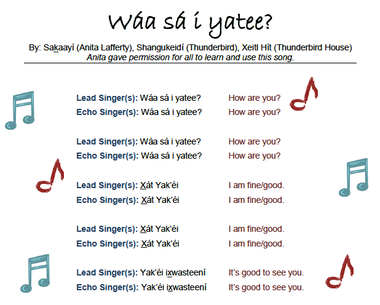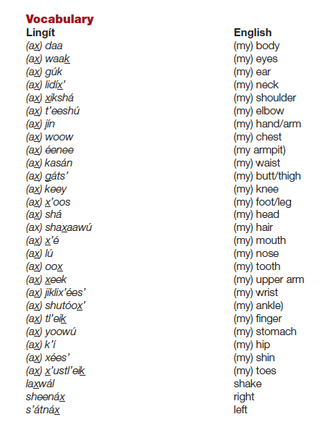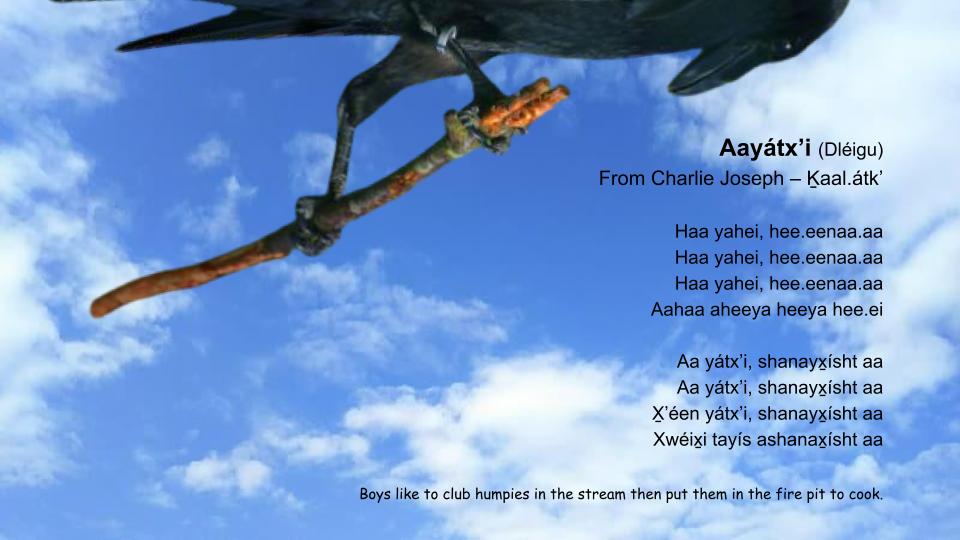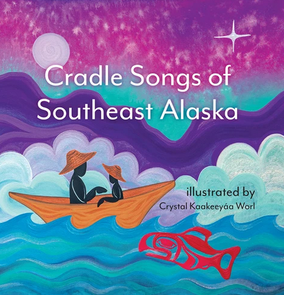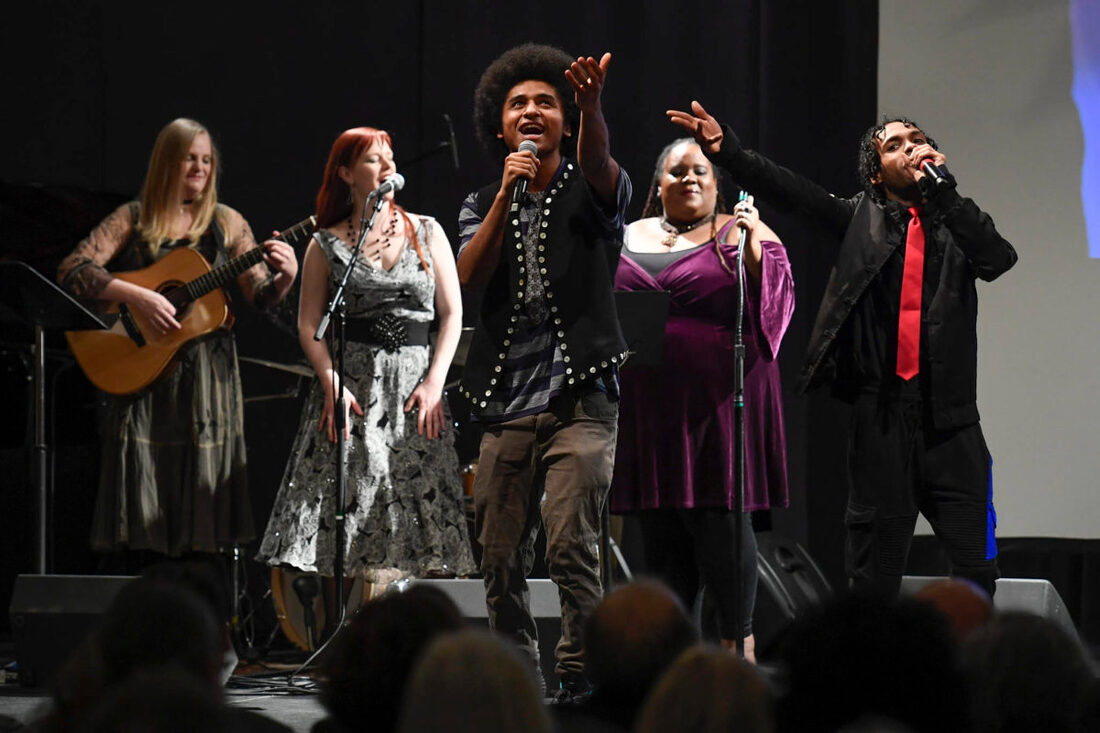Photo (above) by Lyndsey Brollini, courtesy of Sealaska Heritage Institute.
Song Permission:
Most Lingít songs are owned by clans and cannot be taught in school without permission of the clans because they are considered clan property and a clanʼs at.óowu (precious possessions). The following songs are in the public domain, either released by a clan for general use or simply not owned, like childrenʼs songs and lullabies. The background and history of a Lingít song is just as important as the song itself and should be presented before singing it.
As part of this unit, students should be able to introduce the song by sharing its background before singing it. Below is a list all of the Lingít songs included in this unit, along with the answers to these questions, which must be answered and presented to the students before singing them.
As part of this unit, students should be able to introduce the song by sharing its background before singing it. Below is a list all of the Lingít songs included in this unit, along with the answers to these questions, which must be answered and presented to the students before singing them.
|
|
Lesson 1: Haa Ḵusteeyí Chorus & Wáa sá iyatee?
|
Haa Ḵusteeyí (Our Way of Life) Chorus
by Lorrie Gax̱.áan.sán Heagy & Rose Jinkasee.ee Willard The song was created to help children learn how to speak the tribal values with correct pronunciation and tones using music as a tool. |
Wáa sá i yatee?
by Saḵaayí (Anita Lafferty), Shangukeidí (Thunderbird), Xeitl Hít (Thunderbird House) Sakaayí (Anita Lafferty) gave permission for all to use Goldbelt Heritage Foundation has published on its website the song sheet & audio files |
Lesson 2 - 4: Haat Yee Aadéi: A Girlʼs Lullaby (Dléigu)
After hearing and dancing to this dléigu for several lessons, we start to dig into the language and give students opportunities to examine the language - in particular connecting this song to language practice of X̱ and short "a" and long "aa" vowel sounds. We also move from singing Wáa sá i yatee (How are you)? to speaking it as part of daily conversation. Jinkasee.ee introduced the phrase "Yaadu X̱at" for students to say when ready to ask her "How are you?" This gives them another opportunity to practice "X̱" and the short and long vowels for "a" and "aa" respectively.
|
|
|
|
Haat yee aadéi: A Girlʼs Lullaby (Dléigu)
From Charlie Joseph - Ḵaal.átkʼ Kaagwaantaan (Eagle Wolf) A lullaby (not clan owned) Shared by the Sitka Native Education Program Shaaḵindustoow (Ed Littlefield) provided song sheet, notation, history & audio files |
Lingít Dance Movements
Jinkasee.ee (Rose Willard) explains the way in which males and females dance to Lingít music. Students are encouraged to try these motions while listening to Haat Yee Aadéi. |
Lessons 5 & 6: Counting 1- 10
These two songs help teach counting in Lingít. The first counting song the late Vida Davis taught to Jinkasee.ee Willard. The second song integrates saying "Hello" and counting from 1-10 in Lingít. This song was adapted from a childrenʼs song, "Hello Everyone" that Lorrie Heagy learned while in Scotland for a fellowship. The adaptions were made to try to align the high and low tones of the Lingít words to the change in pitches as much as possible. Children love offering a physical movement to do while counting (i.e. jumping jacks, hopping, running). Gunalchéesh, X̱ʼunei Lance Twitchell, for sharing the Counting to 10 poster.
|
Counting Song: 1 - 5
|
Counting Song and Greeting: 1-10
|
Lessons 7 & 8: Daasá iyateen? (What Do You See?)
|
As part of the Scavenger Hunt that was sent home to every K-5 students, we introduced the phrase, "Daa sá iyatéen (What do you see?) to encourage students to use whole sentences when speaking Lingít rather than individual words. Gunalchéesh to Sealaska for providing this song as part of their Sea Mammals Resources document (p. 10), which you can download for free. These vocabulary word reinforce short and long vowel sounds. We also created a GimKit game for students to play at home.
Gunalchéesh to Kyle Worl for introducing GimKit to us! This educational gaming platform provides a free 30-day trial. Our students love it! |
|
Lessons 9 & 10: Ax̱ Shá Ḵa Ax̱ X̱eek (Head & Shoulders)
Much of the kindergarten curriculum is focused on Who Am I? which is a curricular unit published by Sealaska Heritage Institute. Ax̱ Shá Ḵa Ax̱ X̱eek (Head and Shoulders) is included. There are two recordings provided by Jinkasee.ee (Rose Willard) on this Google Slide Presentation: Slide One and Slide Three. The first recording is an introduction and practice of each body part. The audio file on Slide Three includes two repetitions of the song - one slow, the other fast! If you are interested in learning more body part vocabulary, the list below comes from the Who Am I? unit.
Lessons 11 -14: Aayátxʼi (Dléigu) from Charlie Joseph Ḵaal.átkʼ
|
The lullabies shared by Charlie Joseph, Sr. Ḵaal.átkʼ came from generations of parents and grandparents – and shared among communities. Charlie taught and recorded 12 of these lullabies because his daughter, Ethel, who was trying to teach the language, found that these songs were much easier for children to learn than the more difficult clan songs. Traditionally the songs were sung without a drum, but Charlie put a drum beat to them to help the children learn traditional rhythms. Gunalchéesh, Roby Littlefield (Edʼs mom), for providing the history of these songs, including Charlie Joseph Ḵaalʼátkʼs role in the 1980 first Sealaska Elders Conference, held in Sitka.
|
|
Aayátxʼi is one of the 12 lullabies that Charlie taught and recorded. We included this song as part of the Yéil ḵa Tʼa play because the lyric translation is "Boys like to club humpies in the stream then put them in the fire pit to cook." Gunalchéesh, Ed Littlefield, for recording this song and teaching it to our students.
Ed is a composer and arranger, often fusing jazz elements with Native music. He completed an album combining traditional Alaskan Native music with jazz called “Walking Between Worlds” and Aayátxʼ is one of them. Listen to this youtube video, which begins with Ed singing the traditional dléigu before transitioning to his jazz version. Performed by Ed Littlefield & the Native Jazz Trio. |
Aayátxʼi: Ed Littlefield & the Native Jazz Trio
|
Lessons 15 - 17: Berry Picking Song by Ed Shaaḵindustoow Littlefield
|
Ed Littlefield is a freelance percussionist and educator who has worked with our students in the past through Sealaska Heritage Instituteʼs Voices on the Land project. Ed performs in many ensembles of different genres around the Northwest. He wrote the Berry Picking Song for Vera Starbardʼs play Devilfish and has given permission for us to share this song.
He has released two albums featuring his traditional Native melodies with his group, Native Jazz Quartet: Walking Between Worlds and N J Q: Stories. Recently he recorded Lingít lullabies as part of Cradle Songs of Southeast Alaska. |
Lessons 18 & 19: Stand Up, Sit Down Song & Lives in the Woods
The song "Aasgatóoxʼ yéi yatee" (Lives in the Woods) is inspired by the song, "Daa sá iyatéen?" which is a part of the Sealaska Heritage Institute Sea Mammals Unit (p. 10). The song reinforces the tribal value, Wóoch een kayéilʼ yáx̱ nag̱atee, "Let There Be Peace and Harmony Among Each Other" by introducing a new sentence frame that reinforces and respects where humans live (town) and where wild animals live (forest). Yaandu.ein Paul Marks II shares the deep respect that the Lingít people when they are talking to the bears (and killer whales) called "X̱'álaḵ'áns'" in this audio file. Please share this recording with your students when exploring the tribal values of Wóoch een kayéilʼ yáx̱ nagatee.
Yaandu.ein Paul Marks II: Explanation of X̱ʼálaḵʼánsʼ (audio file)
|
|
|
Singing the Tribal Values Kinder - 1st Grade
|
One of the main goals of the Haa Ḵusteeyí framework is to help students learn how to speak the Southeast Tribal Values in Lingít by putting it to song. The Haa Ḵusteeyí "Our Way of Life" song is not a traditional Lingít song, but rather one created from the sounds of the language (i.e. high tones are recognized in the melody by a higher pitch, long vowel sounds have longer note duration). In doing so, we hope to create music that directly supports Lingít language learning in school and at home.
Here is a Google Slide presentation that includes the tribal values we have covered so far. |
|
Air Jazz (AJ): Songwriter and Rapper
What an honor it was for all of the Haa Ḵusteeyí pilot schools to be invited to attend a special presentation by Air Jazz, a young artist who blends hip-hop with his Lingít heritage. Co-hosted by his mentor, TJ Cramer, both rappers shared their love of writing and rapping. As part of their presentation, Air Jazz and TJ modeled a rhyming game they called Lingish - where one person shares a Lingít word or phrase and then the other person tries to rhyme it using English. The kids absolutely loved it! For example, Gunalchéesh rhymes with "I have a peach." What an inspiring session! Gunalchéesh, AJ and TJ!
|
|
|
Wáasá Ḵuyatee? How is the Weather?
|
|
